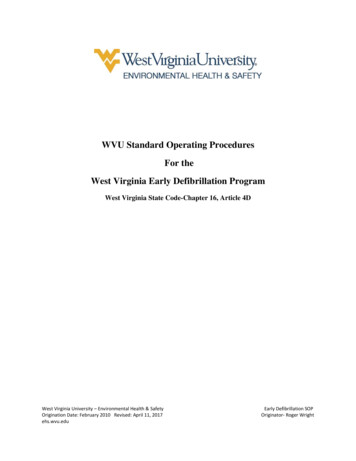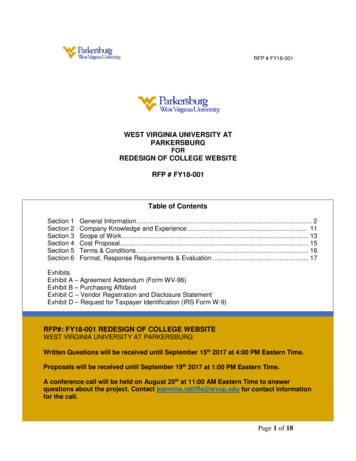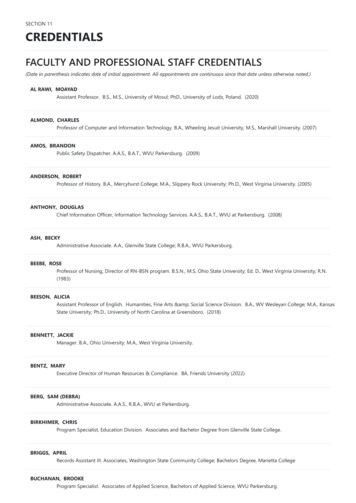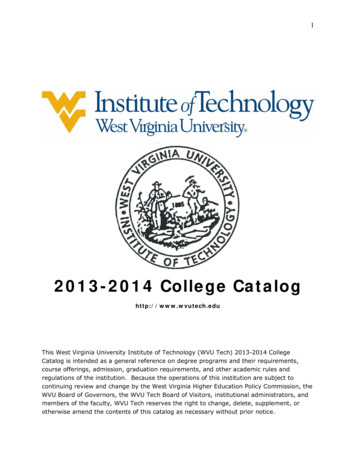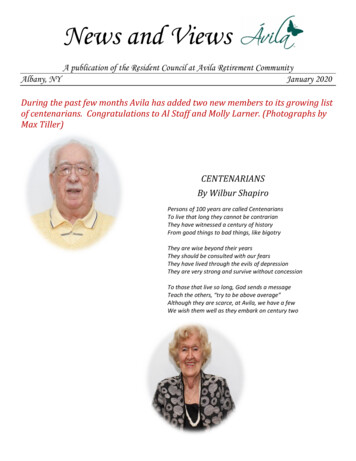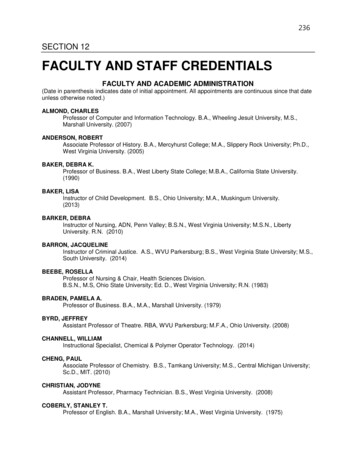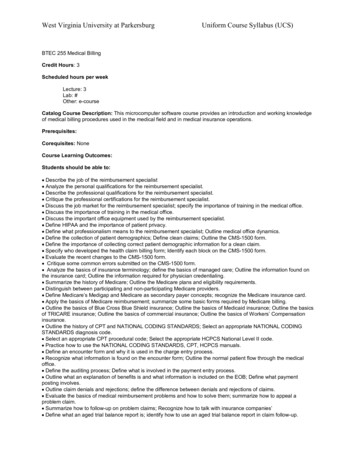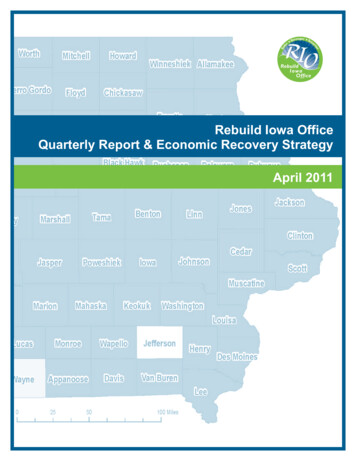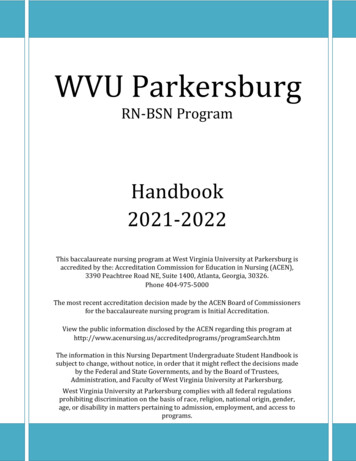
Transcription
WVU ParkersburgRN-BSN ProgramHandbook2021-2022This baccalaureate nursing program at West Virginia University at Parkersburg isaccredited by the: Accreditation Commission for Education in Nursing (ACEN),3390 Peachtree Road NE, Suite 1400, Atlanta, Georgia, 30326.Phone 404-975-5000The most recent accreditation decision made by the ACEN Board of Commissionersfor the baccalaureate nursing program is Initial Accreditation.View the public information disclosed by the ACEN regarding this program ramSearch.htmThe information in this Nursing Department Undergraduate Student Handbook issubject to change, without notice, in order that it might reflect the decisions madeby the Federal and State Governments, and by the Board of Trustees,Administration, and Faculty of West Virginia University at Parkersburg.West Virginia University at Parkersburg complies with all federal regulationsprohibiting discrimination on the basis of race, religion, national origin, gender,age, or disability in matters pertaining to admission, employment, and access toprograms.
August 9, 2021Dear Students,On behalf of the faculty and staff of the Nursing and Health SciencesDivision, I would like to extend a sincere welcome to you. The faculty and Icongratulate you and are delighted that you have selected the RN-BSNprogram at West Virginia University at Parkersburg (WVU atParkersburg).We pride ourselves on the quality of education we have to offer as well as thesuccess our graduates in the Nursing and Health Sciences Division enjoy.The Learning Management Resources, library, and faculty will support youreducational experience as you continue to expand your career opportunitiesin nursing.This handbook has been designed to assist in your orientation to the RN-BSNprogram and to ease your transition as you progress thru the program. Itprovides you with all of the procedures of the program, as well as answers tomany questions you may have. Become familiar with it and utilize it as aresource for your success. Please note that faculty reserves the right toupdate and modify procedures contained within the handbook as needed.Updates that are added throughout the academic year will be provided toyou in writing and can be viewed on-line at www.wvup.edu.The faculty and staff of the nursing program at WVU at Parkersburg arededicated and committed to assist and guide you through your educationalexperience. Faculty post and maintain in –house and online office hourseach week. Appointments can be made through Amy Richards or Becky Ashby calling 304-424-8300. If there is anything we can do for you, please do nothesitate to let us know.Congratulations on your accomplishments thus far. I extend my best wishesto you for a successful and rewarding completion of the RN-BSN program.Sincerely,Rose Beebe, EdD, MS, RNDirector RN-BSN Program2
Table of ContentsIntroduction .4Historical Overview .4Mission .7Philosophy .7Conceptual Framework .8Student Learning Outcomes .9Definition of Terms .11RN-BSN Program ProceduresAdmission to the Program. 15Clinical Practice Requirements . 17Technical Standards . 17On-Line Learning Technology Considerations . 20Tutoring Services . 21Nursing Lab . 21Academic Coaching . 21Program of Study . 22RN-BSN Academic Maps . 23Progress and Performance . 29Professional and Safe Clinical Practice Standards . 31Student Procedures . 32Chain of Command . 33Online Course Participation and Student Conduct. 34Social Media . 39Dress Code . 41Drug and Alcohol . 42Major Changes in Health Status . 45Hepatitis B Vaccination Waiver Form . 46Medical Release Form . 47Academic Honesty . 48Failure to Progress in the Program .50Failure to Progress Plan .51Dismissal from Program .52Graduation Requirements .53Graduation Checklist .53Professional Conduct of Nursing Students. 54WV State Board Procedural Rule Title 19, Series 9. 55WV State Board Legislative Rule Title 19, Series 10 . 59Confidentiality Statement .633
INTRODUCTIONThis Handbook has been prepared for individuals who have been admitted to the RNBSN program. The program has been designed to provide registered nurses with a degreecompletion program that will build on their existing knowledge, skills, and abilities in nursingand clinical application. This handbook provides information about the program and the policiesthat are important for its functioning.Integral to the program’s success is the concept of the Career Ladder approach that issupported by West Virginia University at Parkersburg. A central belief held by the Departmentof Nursing is that ALL levels of nursing are significant contributors to the delivery of health carein a multitude of meaningful activities. The RN-BSN program will provide graduates thefoundation for continuing education in nursing.The RN-BSN curriculum is based on current theory and best practices in nursingeducation. Professional nursing education integrates liberal and nursing education to fostercritical, creative, and reflective thinking skills. In today’s changing healthcare landscape, it isnecessary to prepare professional nurses that can practice effectively within the global society indiverse settings. Nursing education at the baccalaureate level is an active learning process. TheRN-BSN program is evaluated and revised biennially, with updates on a continuous basis, tokeep pace with changing employer demands, student needs, accreditation standards, andtechnology.It is the responsibility of each student to review this handbook regularly and understandits contents. Students may want to consult nursing course syllabi for further guidance withprogram procedures. This handbook is not a contract expressed or implied and the contentsherein are subject to change, revision, cancellation, or withdrawal without published notice andwithout liability. The faculty reserves the right to modify, change, or delete any or all of theseprocedures, in whole or part-as such; students will be notified in writing in a timely fashion. Thishandbook is intended to supplement, not replace, the policy and procedure publications towhich all students of WVU Parkersburg are subject, such as the current WVU ParkersburgCatalog, WVU Parkersburg Student Handbook, and the current WVU Parkersburg SemesterSchedule of Classes.HISTORICAL OVERVIEWThe Parkersburg Branch of West Virginia University (later to become ParkersburgCommunity College), housed in a condemned and abandoned public school building, beganoperations in the Fall of 1961 with 104 students and 6 faculty members. Student enrollment atthe "Branch" experienced steady growth with enthusiastic community support. In 1964, the"Branch" initiated a two-year Associate in Arts Degree Program.In 1965, the citizens of Wood County passed a bond issue, which together with federalfunds, supported construction of a new 3.6 million facility on land donated by the WoodCounty Court. The building was completed in 1969. In March, 1971, the West VirginiaLegislature enabled the then West Virginia University - Parkersburg Center to become the state'sfirst community college in a planned statewide community college system. The name of the4
college was changed to Parkersburg Community College.On July 1, 1989 the college became a part of the University System of West Virginia andwas renamed West Virginia University at Parkersburg. In 2008, the WV Legislature changedWVU Parkersburg's governance structure and relationship to WVU in creating a state network ofindependently accredited community and technical colleges. Local governance is now providedby the WVU Parkersburg Board of Governors under the jurisdiction of the WV Council forCommunity and Technical College Education.WVU Parkersburg is one of 27 public institutions in the United States classified as abaccalaureate/ Associate's College by the Carnegie Foundation for the Advancement ofTeaching. It is the fourth largest public institution of higher education in West Virginia. TheParkersburg campus is the only public community college in West Virginia accredited to offerbaccalaureate degrees.Associate Degree NursingThe program in nursing was developed at the request of the administration and nursingleadership of Camden-Clark Memorial Hospital and St. Joseph's Hospital of Parkersburg. Both ofthese hospitals provided nursing educational programs and had been key suppliers of nurses forthe region; however, they recognized the growing value of relocating these educationalopportunities and responsibilities within an institution of higher learning.Through the leadership and hard work of hospital and college personnel, a smoothertransition from diploma nursing education to associate degree nursing education was carriedout. This new program was greatly strengthened and supported by the experience, knowledge,and resources made available to it by the hospital programs. This Associate Degree NursingProgram had its beginning in August 1967. The first class of graduate nurses numbered 19 in1969. Since its beginning, over 2500 persons have received the Associate in Applied Sciencedegree in Nursing.A New Era in Nursing EducationIn the summer of 2011, the Chancellor for the Community and Technical College Systemof West Virginia (CTCSWV) convened a meeting of the deans and directors of nursing educationprograms in the CTCSWV institutions, along with council members and presidents. The chargeof the gathering was to discuss the recent changes in health care related to higher education.Specifically, the chancellor wanted to explore collaboration, as well as consistency, amongassociate degree nursing programs within the CTCSWV. The intent was to transform nursingeducation in West Virginia.The following institutions recognized the need for change in nursing education andchose to move forward with the development of a common, concept based curriculum: Eastern,BridgeValley, Northern, Southern, and WVU at Parkersburg. The vision of the WVCTCSConsortium of Associate Degree Nursing Programs was to respond to the nursing needs of thepeople of West Virginia by delivering a high-quality nursing educational program to studentsthough innovative curricular design and instruction.5
The nursing program is structured to provide a foundation for career paths for futureleaders in nursing practice and to prepare lifelong learners who demonstrate knowledge, skill,critical thinking, and flexibility. The program values caring, diversity, ethics, excellence, holism,integrity, and patient-centeredness and is committed to providing accessible, high-qualitynursing education to meet the diverse and changing health-care needs of the community andbeyond. This curriculum was implemented in the Fall 2014 at the consortium members’institutions.RN-BSN CompletionWVU at Parkersburg currently provides students with initial entry level into registerednurse practice with the Associate in Applied Science degree.Planning to offer the RN-BSN program at WVU at Parkersburg was initiated the fall 2008.This was necessary due to the restructuring of the higher education system. Effective fall 2009,students applying to West Virginia University’s (WVU) RN-BSN program no longer had the optionto choose the Parkersburg campus as their choice for education. Student advisement andcourse offerings had been managed by the faculty at WVU’s Charleston campus. Given the needfor career advancement of nursing professionals within the region served by WVU atParkersburg, it was deemed imperative to proceed with a request for a RN-BSN program.A team of nursing faculty and college administrators have worked diligently since 2009on this project. The Nursing Advisory Board, which is composed of nursing administrators froma variety of health care providers in the service area, was also consulted. This group has beenvery enthusiastic and supportive of the endeavor to reinstate a RN-BSN program in the area.The topic of RN-BSN education is a regular agenda item at the fall and spring Advisory Boardmeetings. Input from this group has been considered as the program was developed and as itcontinues to evolve.In the spring of 2012, the program structure and curriculum were approved by the WVUat Parkersburg Curriculum Committee and subsequently the WVU at Parkersburg Board ofGovernors. Subsequently, the RN-BSN program has received approval from the West VirginiaHigher Education Learning Commission (HEPC), Community and Technical College System ofWest Virginia (WVCTCS), and Higher Learning Commission (HLC). The RN-BSN program admittedits first cohort summer 2014 and gained initial accreditation by the Accreditation Commissionfor Education in Nursing (ACEN) summer 2016.The RN-BSN completion program has been duly aligned with the Community andTechnical College System of West Virginia (WVCTCS) Consortium of Associate Degree NursingPrograms adoption of the National League for Nursing Outcomes and Competencies forGraduates of Practical/Vocational, Diploma, Associate Degree, Baccalaureate Master’s, PracticeDoctorate, and Research Doctorate Programs in Nursing (2010).6
THE MISSIONThe mission of the RN-BSN program is to increase the number of baccalaureate prepared nursesto positively impact patient outcomes and to provide opportunities for career mobility andgraduate education. The program is committed to providing accessible, high-quality nursingeducation to meet the diverse and changing health-care needs of the community and beyond.THE PHILOSOPHYThe WVU at Parkersburg RN-BSN Program is committed to a quality educational environment.The educational philosophy of WVU at Parkersburg RN-BSN program incorporates the sevencore values of the National League for Nursing Competencies Framework which includes caring,diversity, ethics, excellence, holism, integrity, and patient centeredness (NLN, 2010). Webelieve that “all nurses should display integrity, respect diversity in all forms, uphold given legaland ethical responsibilities and strive for excellence while promoting caring, holistic, patientcentered care” (NLN, 2010).WVU at Parkersburg RN-BSN Program supports education as a life-long process incorporating aspirit of inquiry, supported by evidence-based research. The faculty believes that students needto develop nursing judgment in their practice, develop a professional identity as a nurse, andlearn to support patients and families in development of their ongoing growth as human beings.Life-long learning consists of acquiring knowledge, demonstrating proficient skills, anddeveloping ethical attitudes and values.7
CONCEPTUAL FRAMEWORK(National League for Nursing, 2010, p.8.)The conceptual framework for the WVU at Parkersburg RN-BSN program is based on theNational League for Nursing (NLN) Educational Competencies Model and the components withinit. The model consists of the following components (National League for Nursing, 2010):Core Values: Seven core values, implicit in nursing's historic paradigm, are foundational for allnursing practice. These values are caring, diversity, ethics, excellence, holism, integrity, andpatient-centeredness. They are shown at the root of the model, to indicate that each type ofnursing program and each type of competency must be grounded in these fundamental values(p. 8).Integrating Concepts: Emerging from the seven core values are six integrating concepts:context and environment; knowledge and science; personal and professional development;quality and safety; relationship-centered care; and teamwork. These concepts are shown asbands around the program types, illustrating their progressive and multidimensionaldevelopment in students during their learning experiences. The critical feature of the bands isan enveloping feedback mechanism that acknowledges the ongoing advancement of nursingeducation, as new graduates return new learning, gleaned from multiple sources, to nursing8
practice through nursing education. In this way, nursing practice and nursing education remainperpetually relevant and accountable to the public and all those in need of nursing (NationalLeague for Nursing, 2010, p.8.).Program Student Learner Outcomes: The goals of nursing education for the RN-BSN programcan be summarized in four broad program outcomes. Nurses must use their skills andknowledge to enhance human flourishing for their patients, their communities, and themselves.They should show sound nursing judgment, and should continually develop their professionalidentity. Finally, nurses must approach all issues and problems in a spirit of inquiry. Allessential program-specific core nursing practice competencies and course outcomes areassumed within these four general aims (NLN, 2010, p. 9).END-OF-PROGRAM STUDENT LEARNING OUTCOMESUpon completion of the West Virginia University at Parkersburg Bachelor of Science in Nursingdegree the graduate is prepared to:1. Human Flourishing:Incorporate the knowledge and skills learned to help patients,families, and communities continually progress toward fulfillment of human capacities.2. Nursing Judgment:Make judgments in practice, substantiated with evidence, whichsynthesizes nursing science and knowledge from other disciplines in the provision ofsafe, quality care and the promotion of the health of patients and the community.3. Professional Identity: Express one’s identity as a nurse through actions that reflectintegrity, a commitment to evidence-based practice, caring, advocacy, and safe qualitycare for diverse patients and their communities, and willingness to provide leadership inimproving care.4. Spirit of Inquiry:Act as a scholar who contributes to the development of thescience of nursing practice by identifying questions in need of study, analyzing publishedresearch, and using available evidence as a foundation to propose creative, innovative,or evidence-based solutions to clinical practice problems.Source: Outcomes and Competencies for Graduates of Practical/Vocational, Diploma, Associate Degree,Baccalaureate, Master’s, Practice Doctorate, and Research Doctorate Program in Nursing. Developed by the NationalLeague for Nursing, 2010.9
End-of-Program Student Learning Outcomes, Competencies and Professional StandardsEnd-of-Program Student Learning OutcomesIncorporate the knowledge and skills learned to help patients,Human Flourishingfamilies, and communities continually progress towardfulfillment of human capacities (NLN, 2010, p. 33).Nursing JudgmentProfessional IdentitySpirit of InquiryMake judgments in practice, substantiated with evidence,which synthesizes nursing science and knowledge from otherdisciplines in the provision of safe, quality care and thepromotion of the health of clients and the community(NLN, 2010, p. 34).Express one’s identity as a nurse through actions that reflectintegrity, a commitment to evidence-based practice, caring,advocacy, and safe quality care for diverse clients and theircommunities, and willingness to provide leadership inimproving care (NLN, 2010, p. 35).Act as a scholar who contributes to the development of thescience of nursing practice by identifying questions in need ofstudy, analyzing published research, and using availableevidence as a foundation to propose creative, innovative, orevidence-based solutions to clinical practice problems(NLN, 2010, p. 36).CompetenciesCore Values Caring Diversity Excellence IntegrityIntegrated Concepts Context &Environment Knowledge &Science Personal &ProfessionalDevelopment Quality & Safety RelationshipCentered Care TeamworkRN-BSNProfessional Standards American Nurses Association(ANA) Scope and Standards ofPractice (ANA, 2010) Nursing’s Social PolicyStatement (ANA, 2010) Guide to the Code of Ethicsfor Nurses (ANA 2010[Reissue] Quality and Safety Educationfor Nurses (QSEN)Competencies (QSEN, 2009) Institute of Medicine (IOM)/Robert Wood JohnsonFoundation Collaboration Initiative on the Future ofNursing (IOM, 2010).The WVU at Parkersburg RN-BSN graduates will achieve outcomes by meeting the intended goals of each course in the nursing curriculum. Thestudent learning objectives for each course provide all students the activities for meeting the required core competencies to cultivate thefundamentals and apprenticeships of nursing practice.
DEFINITION OF TERMS(NLN, 2010 taken from Appendix D p.65-69)Caring means "promoting health, healing, and hope in response to the human condition." (NLN, 2010b)."A culture of caring, as a fundamental part of the nursing profession, characterizes our concern andconsideration for the whole person, our commitment to the common good, and our outreach to thosewho are vulnerable. All organizational activities are managed in a participative and person-centered way,demonstrating an ability to understand the needs of others and a commitment to act always in the bestinterests of all stakeholders” (NLN, 2007).Context and Environment, in relation to organizations, refer to the conditions or social system withinwhich the organization’s members act to achieve specific goals. Context and environment are a productof the organization’s human resources, and also the policies, procedures, rewards, leadership,supervision, and other attributes that influence interpersonal interactions. In health care, context andenvironment encompass organizational structure, leadership styles, patient characteristics, safetyclimate, ethical climate, teamwork, continuous quality improvement, and effectiveness.Core Competencies are the discrete and measurable skills, essential for the practice of nursing, that aredeveloped by faculty in schools of nursing to meet established program outcomes. These competenciesincrease in complexity both in content and practice during the program of study. The core competenciesare applicable in varying degrees across all didactic and clinical courses and within all programs of study,role performance, and practice settings. They structure and clarify course expectations, content, andstrategies, and guide the development of course outcomes. They are the foundation for clinicalperformance examinations and the validation of practice competence essential for patient safety andquality care.Course Outcomes are expected culmination of all learning experiences for a particular course within thenursing program, including the mastery of essential core competencies relevant to that course. Coursesshould be designed to promote synergy and consistency across the curriculum and lead to the attainmentof program outcomes.Diversity means recognizing differences among “persons, ideas, values and ethnicities,” while affirmingthe uniqueness of each,” within the context of nursing care (NLN, 2010b). “A culture of diversity embracesacceptance and respect. We understand that each individual is unique and recognize individualdifferences, which can be along the dimensions of race, ethnicity, gender, sexual orientation,socioeconomic status, age, physical abilities, religious beliefs, political beliefs, or other ideologies. Aculture of diversity is about understanding ourselves and each other and moving beyond simple toleranceto embracing and celebrating the richness of each individual. While diversity can be about individualdifferences, it also encompasses institutional and system-wide behavior patterns” (NLN, 2007).
Excellence means “creating and implementing transformative strategies with daring ingenuity.” “A cultureof excellence reflects a commitment to continuous growth, improvement, and understanding. It is aculture where transformation is embraced, and the status quo and mediocrity are not tolerated” (NLN,2010b).Ethics “involves reflective consideration of personal, societal, and professional values, principles andcodes that shape nursing practice. Ethical decision making requires applying an inclusive, holistic,systematic process for identifying and synthesizing moral issues in health care and nursing practice, andfor acting as moral agents in caring for patients, families, communities, societies, populations, andorganizations. Ethics in nursing integrates knowledge with human caring and compassion, whilerespecting the dignity, self-determination, and worth of all persons,” (NLN, 2010a).Holism “is the culture of human caring in nursing and health care that affirms the human person as thesynergy of unique and complex attributes, values, and behaviors, influenced by that individual'senvironment, social norms, cultural values, physical characteristics, experiences, religious beliefs andpractices, and moral and ethical constructs within the context of a wellness-illness continuum,” (NLN,2010a).Human Flourishing can be loosely expressed as an effort to achieve self-actualization and fulfillmentwithin the context of a larger community of individuals, each with the right to pursue his or her own suchefforts. The process of achieving human flourishing is a lifelong existential journey of hope, regret, loss,illness, suffering, and achievement. Human flourishing encompasses the uniqueness, dignity, diversity,freedom, happiness, and holistic well-being of the individual within the larger family, community, andpopulation. The nurse helps the individual in efforts to reclaim or develop new pathways toward humanflourishing.Integrity means "respecting the dignity and moral wholeness of every person without conditions orlimitation," (NLN 2010b). "A culture of integrity is evident when organizational principles of opencommunication, ethical decision making, and humility are encouraged, expected, and demonstratedconsistently. Not only is doing the right thing simply how we do business, but our actions reveal ourcommitmen
Planning to offer the RN-BSN program at WVU at Parkersburg was initiated the fall 2008. This was necessary due to the restructuring of the higher education system. Effective fall 2009, students applying to West Virginia University's (WVU) RN-BSN program no longer had the option to choose the Parkersburg campus as their choice for education.
